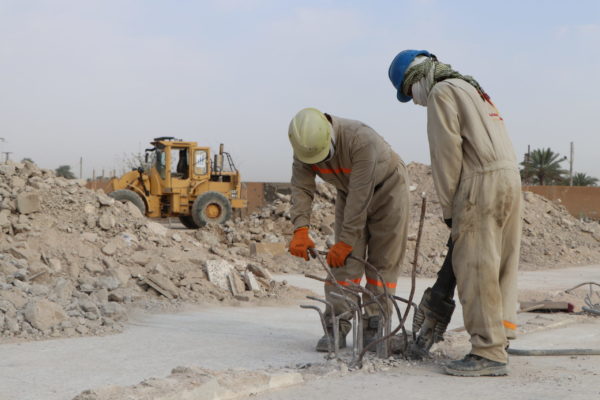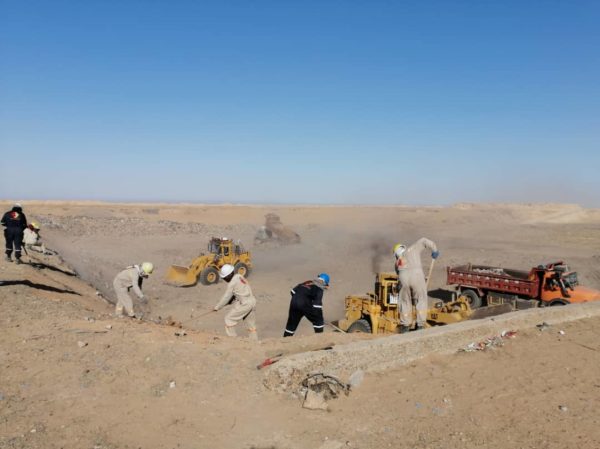Project
Solid Waste Management in North East Syria /

‘The piles of waste created huge problems and tensions between residents in communities. Now the waste has been removed from irrigation sites, the surrounding area has been allowed to recover – people are using the land for agricultural production and are planting more trees.’
Municipal Leader, Deir-ez-Zor, Syria
Crown Agents have been building resilience in North East Syria through the delivery of waste management services for the past three years.
Prior to commencing our waste management programmes, Crown Agents undertook solid waste assessments within the targeted communities including consultations with key stakeholders (local implementing partners, members of the community and local government officials) before defining our scope of work.
OUR WASTE MANAGEMENT ACTIVITIES:
- Community engagement: public health awareness on health risks and project activities; investigation; and public consultations
- Waste collection: distributing waste bins and containers; increased waste collection capacity; street cleaning
- Waste disposal: provision of dumpsite loaders; provision of dumpsite management procedures
- Dumpsite rehabilitation; operations monitoring; dumpsite management training
- Cash for work programming; employment based on vulnerability and need of local people
In the delivery of these programmes, Crown Agents implemented the largest cash-for-work programme in North East Syria. The scheme employed 405 individuals from 9 villages in which the waste management operations were taking place.
By working closely with local implementing partners, providing training for dumpsite managers, and creating job opportunities for local residents, Deir-ez-Zor can now safely receive and process waste from the surrounding area, benefitting over 380,000 local people.
 OUR APPROACH TO WASTE MANAGEMENT SERVICES:
OUR APPROACH TO WASTE MANAGEMENT SERVICES:
Through our previous waste management activities and assessments, we have modelled that for every 1,000 inhabitants in a village (where the average household size is 7 people) there is a daily waste generation of 1.44m3. Extrapolating this to target communities, we are able to calculate the respective number of 1m3 bins to be procured and provided to the village for their waste ‘storage’ until collection. It is recognised that some municipalities have bins and containers already available. In new areas of operation, we undertake surveys during the inception of the locations and conditions of available and usable bins or vehicles. Mapping these allows for appropriate repairs to be conducted, and materials incorporated into planning prior to procurement of new projects.
OUR IMPACT:
Better public health
Drop in parasitic diseases and NTDs (neglected tropical diseases) which are spread by sand flies and other harmful insects and reptiles that live and breed in waste piles. Cases of leishmaniasis for example, have dropped significantly since the waste has been collected and properly managed to very few. Cleaner air with the reduction of burning waste has also contributed to people’s respiratory health, as well as the environment.
Removal of standing waste has led to better social cohesion between communities
Organised waste collection and the creation of job opportunities has led to greater social cohesion between communities since the piles of waste have been removed. The restoration and reclaiming of land will also provide more agricultural land for crop-production.
Controlled and environmentally safe disposal of waste
Training and capacity building at both the community and municipal levels, in which community engagement is leveraged to build health and environmental campaigns surrounding the importance of safe control and disposal of waste, ensuring public buy-in and engaged with waste management services.
The highest standards of staff welfare, including rigorous training, PPE, working hours, sick pay and critical injury insurance
Prioritising the most vulnerable members of the community through vulnerability assessments and outreach ensured that transparency among workers over job creation. Sick pay, critical injury insurance and rigorous training including the safe disposal of ERW were also provided. The rotation of workers for waste management activities ensured that we were able to employ the maximum number of workers for available positions.
Watch our project video here: